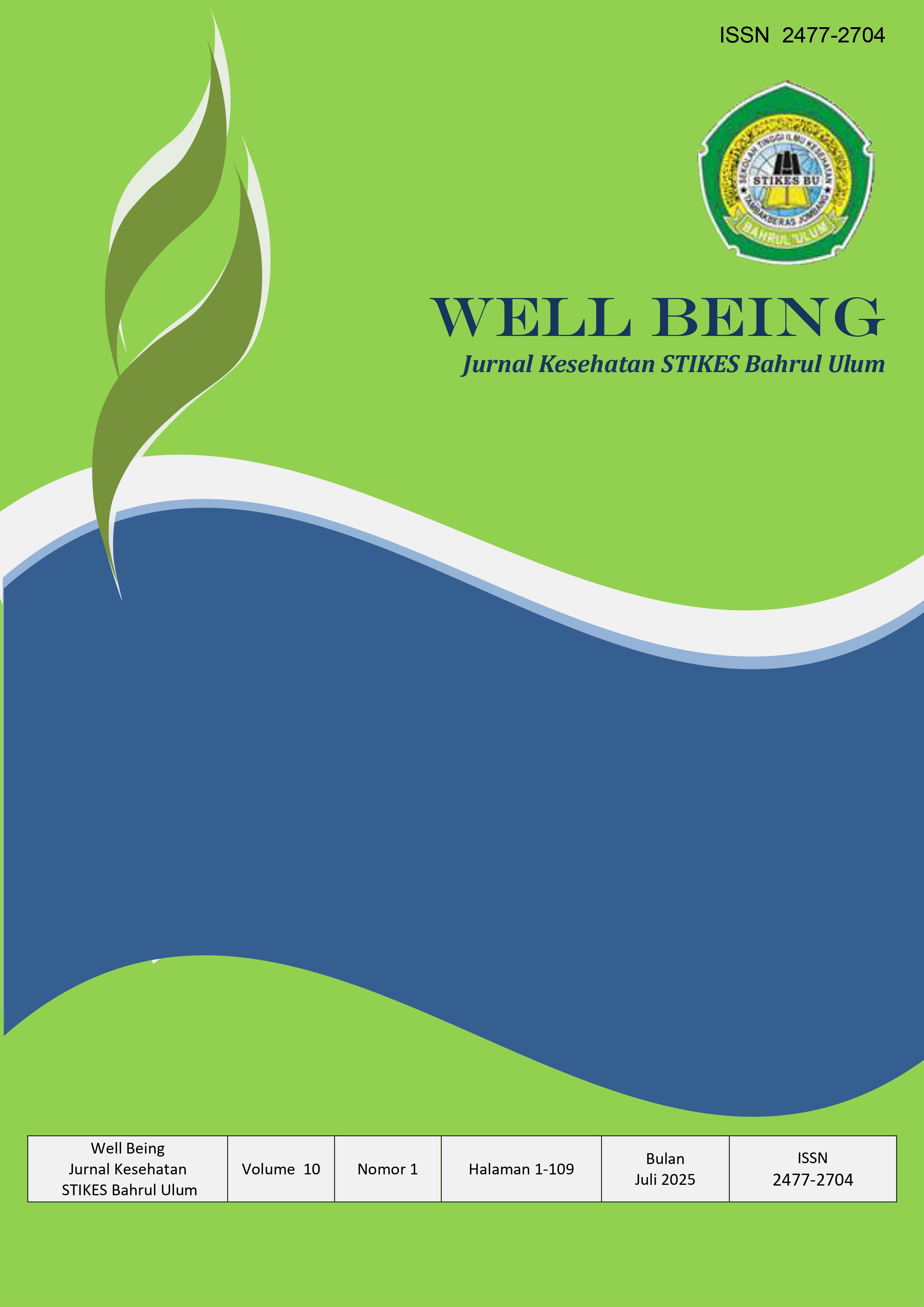PENERAPAN FIVE-FINGER RELAXATION TECHNIQUE UNTUK MENURUNKAN ANXIETY PADA PASIEN STROKE NON-HEMORAGIK
APPLICATION OF THE FIVE-FINGER RELAXATION TECHNIQUE TO REDUCE ANXIETY IN NON-HEMORRHAGIC STROKE PATIENTS
DOI:
https://doi.org/10.51898/wb.v10i1.335Keywords:
Non-hemorrhagic stroke, anxiety, five-finger relaxation techniqueAbstract
Background: Stroke is one of the leading causes of death and disability worldwide. The most common type of stroke is non-hemorrhagic stroke, which is a disruption in blood flow to the brain due to a blockage that causes brain tissue damage. Non-hemorrhagic stroke patients often experience anxiety due to physical and mental changes, as well as uncertainty about the healing process. One non-pharmacological intervention that can reduce anxiety levels is the five-finger relaxation technique. Objective: To describe the application of the five-finger relaxation technique to reduce anxiety levels in non-hemorrhagic stroke patients. Methods: This descriptive study used a case study method on two non-hemorrhagic stroke patients with anxiety at Waikabubak Regional Hospital. The intervention was administered for three days. Results: Patient 1 showed a decrease in respiratory rate from 24x/minute to 20x/minute, blood pressure from 160/97 to 135/87 mmHg, and anxiety score from 51 (moderate) to 38 (mild). The patient looked more relaxed, enthusiastic, comfortable, and no tremors. Patient 2 showed a decrease in respiratory rate from 23x/minute to 18x/minute, blood pressure from 157/95 to 130/70 mmHg, and anxiety score from 53 (moderate) to 42 (mild). The patient looked calmer and less pale. Conclusion: The five-finger relaxation technique is effective in reducing anxiety and stabilizing vital signs, especially respiratory rate, in non-hemorrhagic stroke patients by calming the nervous system, this therapy helps patients feel calmer and supports the healing process without interfering with other medical therapies. Suggestion: The application of the five-finger relaxation technique should be done if feeling anxious and stressed to reduce anxiety in non-hemorrhagic stroke patients.References
Aeni, I. E. N., & Mariyati. (2022). Penerapan Hipnosis 5 Jari Untuk Mengurangi Kecemasan Pada Ibu Hamil. Jurnal Keperawatan, 14 (S4), 1119–1126. http://journal.stikeskendal.ac.id/index.php/Keperawatan
Ayu Ria Widiani, G., & Mahardika Yasa, I. M. (2023). Korelasi Tingkat Pengetahuan Terhadap Kemampuan Deteksi Dini Gejala Stroke Dengan Sikap Keluarga Terhadap Penanganan Pre Hospital. Bina Generasi : Jurnal Kesehatan, 14(2), 25–30. https://doi.org/10.35907/bgjk.v14i2.255
Dinas Kesehatan Sumba Barat. (2024). Rekapan Harian Stroke Kabupaten Sumba Barat 2022 - 2024.
Fadli Syamsuddin, & Riyana Nur Ridwan Adam. (2023). Analisis Praktik Klinik Keperawatan Pada Pasien Stroke Non Hemoragik dengan Pemberian Latihan Pemasangan Puzzle Jigsaw Terhadap Peningkatan Kekuatan Otot Ekstermitas Atas Rsud Prof. Dr. H. Aloei Saboe Kota Gorontalo. Jurnal Rumpun Ilmu Kesehatan, 3(2), 109–118. https://doi.org/10.55606/jrik.v3i2.1844
Fauzi, A., & Putri. (2022). Hubungan Tanda-Tanda Vital Dengan GCS Pasien Stroke. Jurnal Keperawatan Malang, 7(1), 89–103.
Ghanesia, H., Shifa, N. A., & Sarwili, I. (2022). Edukasi Hipnotis Lima Jari dalam Menurunkan Tingkat Kecemasan. Pengabdian Masyarakat Saga Komunitas, 1(4), 107–110.
Ilham Darmawan, Indhit Tri Utami, A. T. P. (2024). Penerapan Range Of Motion (ROM) Exercise Bola Karet Terhadap Kekuatan Otot Pasien Stroke Non Hemoragik. Jurnal Cendikia Muda, 4, 246–254.
Jojang, H., Runtuwene, T., & P.S., J. M. (2019). Perbandingan NIHSS pada Pasien Stroke Hemoragik dan Non-Hemoragik yang Rawat Inap di Bagian Neurologi RSUP Prof. Dr. R. D. Kandou Manado. E-Clinic, 4(1), 3–6.
Kemenkes RI (2022). (n.d.). Profil Kesehatan Indonesia. Profil Kesehatan Indonesia.
Katoh, M., Ueha, R., Sato, T., Sugasawa, S., Goto, T., Yamauchi, A., & Yamasoba, T. (2022). Choice of Aspiration Prevention Surgery for Patients With Neuromuscular Disorders: Report of Three Cases. Frontiers in Surgery, 6(November), 1–8.
Kumalasari, D. N., Nugraha, D. A., & Hamidah, N. A. (2024). Kombinasi SWD , ES , Dan Five Finger Spread Exercise Untuk Mengurangi Nyeri Serta Meningkatkan Kekuatan Otot Pasien Post CVA Infark. Abstrak. 16(September), 295–302.
Listari, R. P., Septianingrum, Y., Wijayanti, L., Sholeha, U., & Hasina, S. N. (2023). Pengaruh Fasilitasi Neuromuskuler Proprioseptif dengan Tingkat Kemandirian terhadap Aktivitas Sehari-Hari pada Pasien Stroke: A Systematic Review. Jurnal Keperawatan, 15(2), 737–750.
Meutia, S., Utami, N., Rahmawati, S., & Himayani, R. (2021). Sistem Saraf Pusat dan Perifer. Medical Profession Journal of Lampung, 11(2), 306–311.
Norkhalifah, Y., & Mubin, M. F. (2022). Pengaruh Hipnotis Lima Jari terhadap Kecemasan pada Penderita Hipertensi. Ners Muda, 3(3).
Patola, A., & Tridiyawati, F. (2022). Comprehensive nursing journal. Jurnal Keperawatan Komprehensif, 8(April), 203–211.
PPNI, Tim Pokja. (2018). Standart Intervensi Keperawatan Indonesia.
Riandini, W. O., Fadhilah, N., & . Y. (2018). Faktor-Faktor Yang Berhubungan Dengan Tingkat Kecemasan Keluarga Pasien Stroke Di Rumah Sakit Mitra Husada Pringsewu. Jurnal Ilmiah Kesehatan, 7(1), 20–26.
Rumah sakit Umum. (2024). Jumlah Kasus Stroke. Rumah Sakit Umum Daerah Waikabubak 2022-2024.
Setiawan, N. A., & Imamah, I. N. (2023). Penerapan Hipnosis Lima (5) Jari Terhadap Tingkat Kecemasan Pada Mahasiswa Tingkat Akhir Di Universitas ’Aisyiyah Surakarta. Jurnal Ilmiah Ilmu Kesehatan Dan Kedokteran, 1(4), 80–94.
Sherina, N., Ramdan, D., & Hidayat, N. (2022). Assistancy of Medical Surgical Nursing for Patients with Nervous System Disorders (Hemorrhagic Stroke) in Flamboyant Room, General Hospital of Banjar. Kolaborasi Jurnal Pengabdian Masyarakat, 2(2), 175–197.
Tuban, I. (2023). Penyuluhan Tentang Upaya Menghindari Stroke Pada Ibu Rumah Tangga. Jurnal Pengabdian Kepada Masyarakat, 3(3).
Widiyono, W., Herawati, vitri dyah, & Nurani, W. (2023). Terapi Cermin Dapat Meningkatkan Kekuatan Otot Pada Penderita Stroke Non Hemoragik. Jurnal Keperawatan Malang (JKM), 8(1), 339–353.
Wicaksana, I., Wati, A., & Muhartomo, H. (2021). Perbedaan Jenis Kelamin Sebagai Faktor Risiko Terhadap Keluaran Klinis Pasien Stroke Iskemik. Diponegoro Medical Journal, 6(2), 655–662
Wulandari, T. Suraning, Kurniawati, R., & Azizatul Ilmiyah, V. (2023). Efek Musik Suara Alam (Nature Sounds Music) Terhadap Penurunan Kecemasan pada Pasien Pasca Stroke. Jurnal Kesehatan, 12(1), 12–18.
Wijaya, A. K. (2020). Patofisiologi Stroke Non-Hemoragik Akibat Trombus.E-Jurnal Medika Udayana, 2(10), 1–14.
Downloads
Published
How to Cite
Issue
Section
License
Copyright (c) 2025 Delsiana Nora Ngaji Pige, Shelfi Dwi Retnani Putri Santoso, Wanto Paju, Uly Agustine

This work is licensed under a Creative Commons Attribution-NonCommercial-ShareAlike 4.0 International License.
Authors retain copyright and grant the journal right of first publication with the work simultaneously licensed under a Creative Commons Attribution-ShareAlike 4.0 International License that allows others to share the work with an acknowledgement of the work's authorship and initial publication in this journal.















